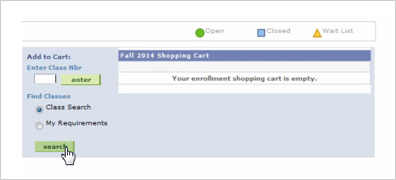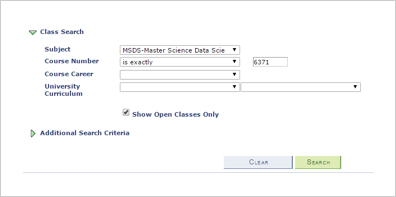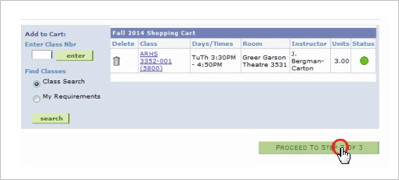Registration
You can register for classes each semester by logging into my.SMU with your student ID. For detailed instructions (including step-by-step instructions), please see below or download the Registration Guide. Important dates and registration deadlines are also listed below.
All registration policies and deadlines are published in the DataScience@SMU Student Handbook.
Important Dates:
May 2019:
March 25: Registration is open
May 5 – 10: Add/drop period with full refund of tuition
May 5: First day of classes
May 10: Last day to drop a course without grade record and with a refund
August 22: Last day of classes (includes exams)
September 2019:
July 8: Registration is open
August 25 – 30: Add/drop period with full refund of tuition
August 25: First day of classes
August 30: Last day to drop a course without grade record and with a refund
December 12: Last day of classes (includes exams)
You can find the full academic calendars here:
Clearing Registration Holds
Students who fail to meet certain university requirements may receive a hold on their account preventing them from registering for classes.
There are dozens of possible account holds, but the most common include:
- Financial (outstanding bills)
- Departmental (academic progress)
- Missing emergency contact information
- Conditional admission holds (missing documents)
You can view holds on your account in my.SMU. If it is a financial hold, the only way to lift it is to pay the balance due. Departmental holds are also viewable in my.SMU but the you must contact the department for instructions to lift the hold.
Contact Student Support if you have questions about clearing a hold on your account.
Registration Instructions
- Log into your my.SMU account at my.smu.edu.
- Select “Student Center” in the upper-right section of the my.SMU home page.

- Select “Enroll” in the upper-left corner under the “Academics” section.

- You may be prompted to select the term you will be registering for; select your starting term.
- Scroll down and confirm “Class Search” is selected under “Find Classes.” Click “Search.”

- Under “Subject,” select “DS-Master Science Data Scie.” Make sure that under the “Course Number” you have “is exactly” selected. To the right, enter the course number. Ex: DS 6371- Statistical Foundations for Data Science: The course number is 6371.

- You’ll see several options available for each course. Click the green “Select Class” button once you’ve located the class that will work for you.
- Select “Next” and you’ll return to your Shopping Cart area. You can either continue by clicking “Proceed to Step 2 of 3” to complete your registration, or you can search for another class. Follow steps 5–7.

- Once you’ve selected all classes for your term, select “Proceed to Step 2 of 3.”
- Confirm your schedule is correct, and select “Finish Enrolling.”

Curriculum and Course Sequencing
You can find more detailed information about the curriculum, including course descriptions, on the DataScience@SMU Courses page.
Course Sequence:
The following is the course sequence for students following the full-time track. The full-time track is 5 terms and can be completed in 20 months. To learn more about the part-time track, please visit the DataScience@SMU Program Tracks page.
First Semester
| Course | Credits |
|---|---|
DS 6371 Statistical Foundations for Data Science | 3 |
DS 6306 Doing Data Science | 3 |
DS 6110 Immersion1 | 1.5 |
Total | 6 or 7.5 credits |
Second Semester
| Course | Credits |
|---|---|
DS 7330 File Organization and Database Management | 3 |
DS 6372 Applied Statistics: Inference and Modeling | 3 |
DS 6110 Immersion1 | 1.5 |
Total | 6 or 7.5 credits |
Third Semester
| Course | Credits |
|---|---|
DS 7349 Data and Network Security | 3 |
DS 7331 Data Mining | 3 |
Total | 6 |
Fourth Semester
| Course | Credits |
|---|---|
DS 6390 Visualization of Information | 3 |
Elective | 3 |
DS 6120 Capstone A2 | 1 |
Total | 7 |
Fifth Semester
| Course | Credits |
|---|---|
DS 7333 Quantifying the World | 3 |
Elective | 3 |
DS 6130 Capstone B2 | 1 |
Total | 7 |
Electives
| Course | Credits |
|---|---|
DS 6391 Creative Coding and Visualization II | 3 |
DS 6383 Econometrics | 3 |
DS 7346 Cloud Computing | 3 |
DS 7335 Machine Learning | 3 |
DS 6391 Visualization of Information and Creative Coding II | 3 |
DS 6370 Statistical Sampling | 3 |
DS 7337 Natural Language Processing | 3 |
DS TBD Business Intelligence and Time Series Analysis with R | 3 |
1Immersion must be taken within the first two terms↑ 2Capstone prerequisite: students must complete a minimum of 12 credit hours prior to registering for the Capstone course.↑
Booklist
The following texts are required for DataScience@SMU courses. Please note: required textbooks are subject to change, so it is advised that you only purchase books for the semester in which you are registered.
Statistical Foundations for Data Science
Ramsey, Fred, and Daniel Schafer. The Statistical Sleuth: A Course in Methods of Data Analysis, 3rd edition. Boston, MA: Brooks/Cole, 2013.
SAS Essentials: A Guide to Mastering SAS for Research E-BOOK.
Doing Data Science (2 books)
Gandrud, Christopher. Reproducible Research With R and RStudio. Boca Raton, FL: CRC Press, 2015.
O’Neil, Cathy, and Rachel Schutt. Doing Data Science: Straight Talk From the Front Line. Sebastopol, CA: O’Reilly Media, Inc., 2014.
Applied Statistics: Inference and Modeling (Same book as Statistical Foundations for Data Science)
Ramsey, Fred, and Daniel Schafer. The Statistical Sleuth: A Course in Methods of Data Analysis, 3rd edition. Boston, MA: Brooks/Cole, 2013.
File Organization and Database Management
Silberschatz, Abraham, Henry F. Korth, and S. Sudarshan. Database System Concepts, 6th edition. New York: McGraw-Hill, 2011.
Visualization of Information
Greenberg, Ira, Dianna Xu, and Deepak Kumar. Processing: Creative Coding and Generative Art in Processing 2. New York: Springer Science and Business Media, 2013.
Data and Network Security
William Stallings. Cryptography and Network Security: Principles and Practice, 6th edition. Upper Saddle River, NJ: Pearson, 2014.
Data Mining
Tan, Pang-Ning, Steinbach, Michael, and Vipin Kumar. Introduction to Data Mining. Upper Saddle River, NJ: Pearson, 2005.
Statistical Sampling
Blair, Edward, and Johnny Blair. Applied Survey Sampling. Thousand Oaks, CA: SAGE Publications, Inc., 2015.
Quantifying the World (2 books)
Nolan, Deborah, and Duncan Temple Lang. Data Science in R: A Case Studies Approach to Computational Reasoning and Problem Solving. Boca Raton, FL: CRC Press, 2015.
McKinney, Wes. Python for Data Analysis. Sebastopol, CA: O’Reilly Media, Inc., 2014. Available in PDF download (McKinney).








